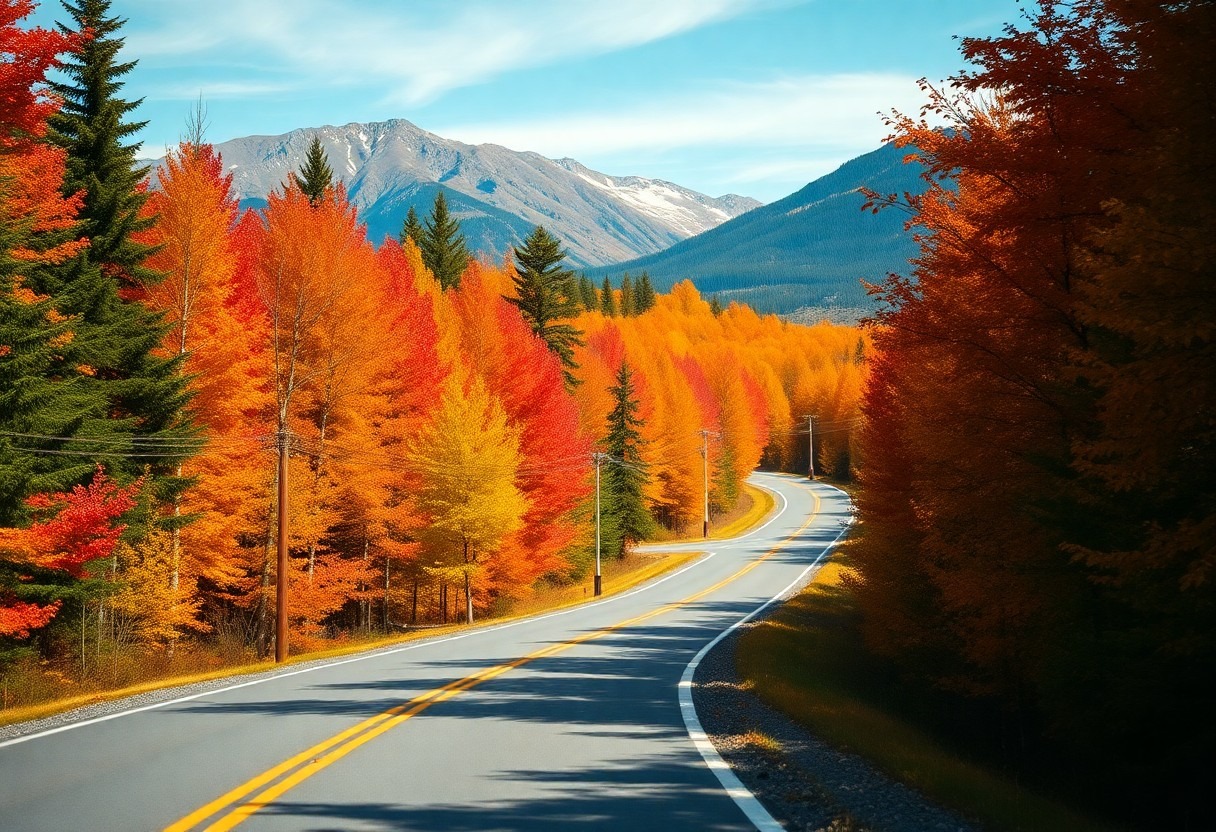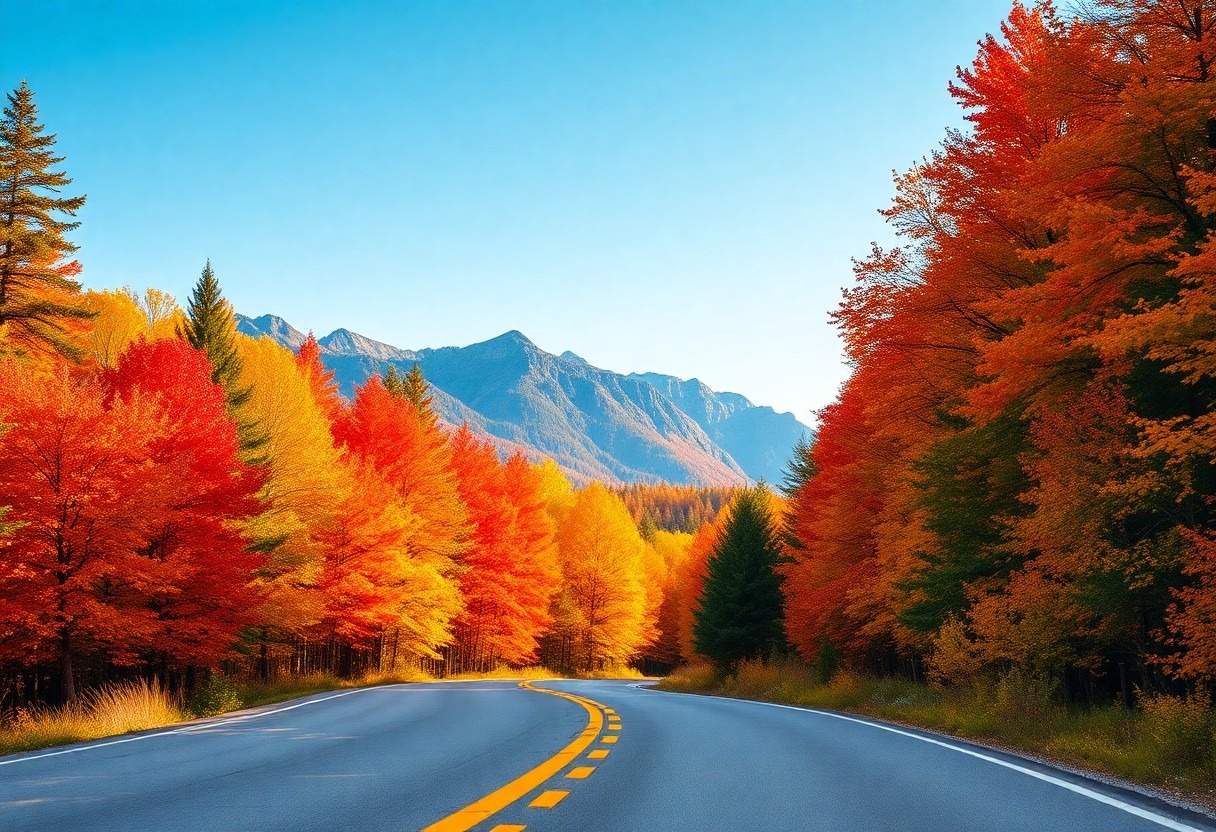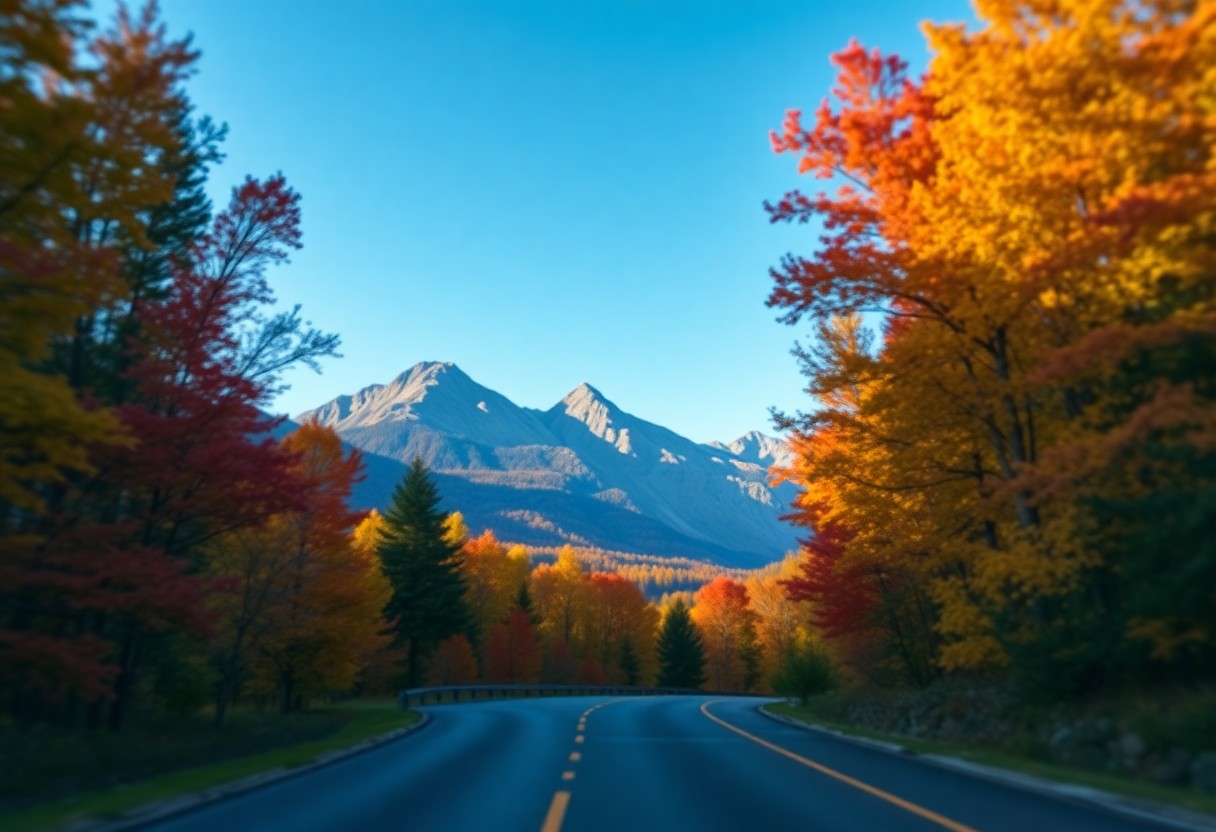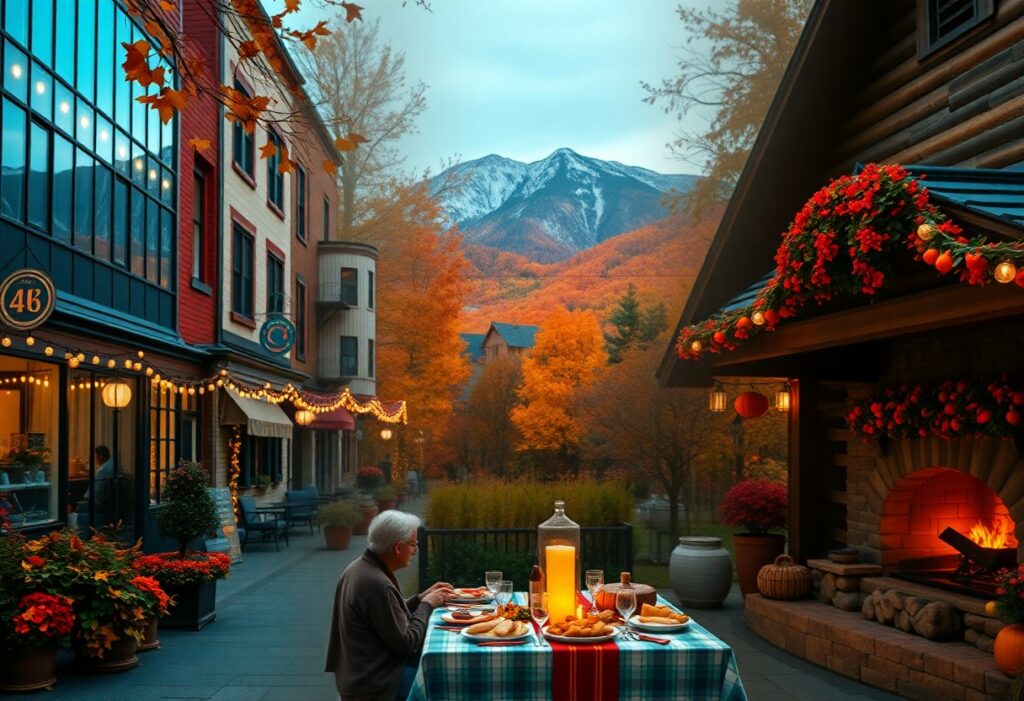Driving through America’s most beautiful autumn landscapes can give you unforgettable views of nature’s color show. As you plan your fall road trip, you’ll discover routes that wind through vibrant displays of red, orange, and golden leaves across the country. From New England’s maple-lined highways to the aspen-covered mountains of Colorado, these scenic drives offer you the perfect opportunity to experience fall’s spectacular transformation. You’ll want to time your visit carefully, as peak foliage seasons vary by region and typically last only a few weeks, making these drives some of the most anticipated seasonal attractions in the U.S.
Popular Fall Foliage Routes in America
The U.S. offers over 150,000 miles of scenic byways for your perfect autumn adventure to witness nature’s spectacular color show. From the iconic roads of New England to the hidden gems of the Pacific Northwest, you’ll find routes that showcase the best fall colors between September and early November.
Northeast Region Drives
Now, you can explore the country’s most celebrated fall foliage destinations. The Kancamagus Highway in New Hampshire and Vermont’s Route 100 offer prime viewing spots where sugar maples, birch, and beech trees create a stunning display of red, orange, and gold hues. Plan your visit during peak season in early October for the best color intensity.
Southeast and Mid-Atlantic Routes
The region’s Blue Ridge Parkway stretches through Virginia and North Carolina, offering 469 miles of uninterrupted scenic beauty. Diverse tree species create a multicolored canvas against the mountain backdrop. The best viewing time is mid-October to early November.
Route planning should include stops at the numerous scenic overlooks along these parkways. The parkway’s elevation changes from 650 to 6,000 feet, providing diverse viewing perspectives. It also features safe pull-offs every few miles, letting you capture perfect photos while avoiding road hazards.

Essential Planning Factors
Unlike summer road trips, fall foliage drives require specific timing and preparation. Your journey needs careful consideration of weather patterns, road accessibility, and peak color periods. Recognizing these elements will help you plan the perfect autumn adventure.
Peak Foliage Timing
The timing of fall colors varies by region and elevation. Northern states and higher elevations typically display colors first, typically in late September, while southern regions peak in late October. Your best resources are local foliage trackers and state tourism websites that provide weekly updates.
Route Conditions
Factors affecting your drive include weather changes, road maintenance, and tourist traffic. Before setting out, you should check road closures and construction updates, as autumn brings increased maintenance activity on scenic routes.
It’s crucial to prepare for sudden weather shifts during your fall drive. Pack emergency supplies and keep your gas tank full, as some scenic routes have limited services. Your drive will be more enjoyable if you avoid peak weekend crowds by planning mid-week trips. Many roads offer designated photo stops where you can safely capture the colorful views.
- Check weather forecasts daily
- Monitor road status updates
- Plan for shorter daylight hours
- Bring appropriate clothing layers
- Pack emergency supplies

Trip Planning Tips
Not all fall foliage trips are created equal. Your journey requires careful timing and route planning to catch peak colors. Check local foliage trackers and weather forecasts before setting out. Pack crucial items like maps, snacks, and emergency supplies. Assume popular viewing spots will be crowded during peak weekends, so plan for early morning starts.
Pre-Drive Preparations
While preparing for your fall foliage adventure, ensure your vehicle is in optimal condition. Check your tires, brakes, and fluid levels. Pack a basic emergency kit, warm clothing, and sufficient water. Your mobile phone should be fully charged, and you should download offline maps for areas with limited cell service.
Photography Guidelines
With your camera ready, focus on capturing the best fall colors during the golden hour – the first hour after sunrise or before sunset. Use your polarizing filter to reduce glare and enhance color saturation. Keep your camera settings optimized for landscape photography with a small aperture for maximum depth of field.
Planning your photo stops will help you maximize your drive. Look for elevated viewpoints that offer panoramic views of the colorful valleys below. Include interesting foreground elements like rustic fences or winding roads to add depth to your compositions. Your best shots will often come from unexpected locations, so be ready to pull over when you spot a perfect scene safely.
- Check weather conditions daily
- Start early to avoid crowds
- Bring appropriate gear
- Follow local parking rules
- Share your location with someone
Driving Safety Guidelines
Due to winding roads and changing weather conditions, many fall foliage drives require your full attention. You need to plan your route, check your vehicle’s condition, and stay alert for other leaf-peeping tourists who might suddenly stop for photos.
Weather Considerations
Driving during fall requires extra caution due to wet leaves and early sunsets. You should check local weather forecasts before your trip and be prepared for sudden changes in visibility and road conditions. Your vehicle needs proper tire traction and working wipers for safe travel.
Road Safety Tips
Assuming you’re planning a fall foliage drive, follow these imperative guidelines:
- Maintain a safe following distance (at least 3 seconds)
- Use headlights in low-light conditions
- Avoid sudden braking on leaf-covered roads
- Keep your fuel tank at least half full
Perceiving road hazards early gives you more time to react safely.
Considerations for your fall drive should include:
- Pack an emergency kit with blankets and flashlights
- Share your travel plan with family or friends
- Download offline maps for areas with poor cell service
- Carry essential tools and a spare tire
Perceiving potential challenges before they become problems helps ensure a safe and enjoyable journey.

Best Viewing Points
To maximize your fall foliage viewing experience, you’ll find designated observation points along these scenic routes. These spots are specifically chosen to offer panoramic views of the colorful landscapes, with many featuring interpretive signs that help you identify different tree species and their fall colors.
Scenic Overlooks
Assuming you plan to photograph the fall colors, you’ll want to visit the overlooks during peak morning or late afternoon hours when the light is most favorable. The Blue Ridge Parkway offers over 200 scenic overlooks, while Vermont’s Route 7 features multiple pull-off areas with stunning mountain backdrops.
Hidden Gems
Little-known spots often provide the most rewarding experiences. You can discover secluded viewing areas by talking to residents or visiting visitor centers. The Inyo National Forest’s back roads lead to spectacular aspen groves that few tourists see.
Understanding the local terrain helps you find these hidden viewpoints. Secret spots can be accessed through hiking trails that branch off from main roads. These locations often provide unobstructed views and fewer crowds. The Adirondacks’ Route 30 features several unmarked pullouts that showcase pristine lakes surrounded by vibrant fall colors.
Additional Travel Considerations
After choosing your scenic route, plan your fall foliage trip with careful attention to timing. The peak color periods typically last only 1-2 weeks and vary by location. Before your journey, check local foliage trackers and weather forecasts. Pack imperative items like warm layers, good walking shoes, and camera equipment.
Accommodation Options
Some of the best lodging choices along these scenic routes include cozy B&Bs, mountain lodges, and boutique hotels. You’ll find peak season rates from September to November, ranging from $150 to $400 per night. Book your accommodations at least 2-3 months in advance, as properties in popular leaf-peeping destinations fill up quickly.
Local Attractions
Planning helps you make the most of your fall foliage trip. Many destinations offer seasonal festivals, harvest events, and guided nature walks. Along your chosen route, you can enhance your experience with stops at local apple orchards, pumpkin patches, and farmers’ markets.
Another way to maximize your fall road trip is to include visits to historic sites and state parks along your route. These locations often provide unique vantage points for foliage viewing and photography. Many parks offer ranger-led programs during peak season, giving you expert insights into the local ecosystem and fall color changes.
Summing up
With this in mind, you can plan your perfect fall foliage road trip across the U.S. by choosing from these stunning scenic routes. Your options range from Vermont’s classic Route 7 to Oregon’s historic Columbia River Highway, each offering unique views of autumn colors. Depending on your chosen location, you will find peak viewing times from late September through early November. These routes give you access to some of America’s most beautiful fall landscapes, from the East Coast’s maple-lined roads to the West Coast’s golden aspens. Pack your camera and hit the road to catch these seasonal displays before the leaves fall.
FAQ
What are the best months to see fall foliage in the United States?
Fall foliage viewing varies by region. Northern states like Vermont and Michigan show peak colors from late September to mid-October. In southern years, the Blue Ridge Parkway displays its best colors from mid-October to early November. Western states like California and Washington offer prime viewing in early to mid-October.
Which scenic drives offer the shortest routes for weekend trips?
The Columbia River Highway in Oregon spans 75 miles and provides a perfect weekend getaway with views of waterfalls and colorful trees. Connecticut’s Litchfield County offers short drives through New England landscapes close to New York City. Vermont’s Route 7 provides compact north-south routes with many small towns for overnight stays.
What should visitors pack for a fall foliage road trip?
Visitors should bring a camera to capture the colorful landscapes, warm clothes to keep them warm when temperatures change, comfortable walking shoes for scenic stops, and a map or GPS device. A picnic blanket and snacks allow for spontaneous stops at scenic overlooks. Water bottles and a first-aid kit are baessentialafety items for any road trip.




As I read your post, I am reminded of the profound connection we have with nature, especially during the fall when the landscape transforms into a breathtaking tapestry of colors. Last year, I embarked on a road trip through the Blue Ridge Parkway, and the experience was nothing short of magical. The vivid reds and oranges seemed to envelop us as we wound through the mountains, creating an almost surreal atmosphere.
Your description of the Blue Ridge Parkway really resonates with me. There’s something transformative about fall that makes us more aware of nature’s beauty, isn’t there? Those vibrant reds and oranges can feel almost otherworldly, wrapping us in a warm embrace as we drive through the mountains. It’s like the landscape is putting on its finest attire to say goodbye to summer.
The way you describe your experience on the Blue Ridge Parkway really captures what makes fall so special. It feels like nature is putting on a show just for us, doesn’t it? Those vibrant colors can be mesmerizing, almost like they’re coaxing us to slow down and appreciate the moment.
Your observation about nature putting on a show really resonates with me. There’s something inherently inviting in the way the landscape transforms during autumn. Those vibrant colors, shifting from deep greens to explosive oranges and fiery reds, offer a reminder of the transient beauty that surrounds us. It’s as if each leaf is a little celebration of the season, urging us to pause and take a moment to absorb our surroundings.
You hit the nail on the head about fall and the beauty of the Blue Ridge Parkway. It really does feel like nature is putting on a show, and those vibrant colors do have a unique way of pulling us into the moment. There’s something soothing about the rustling leaves and the crisp air that invites reflection. I often find that when I’m out there, I can’t help but think about the fast pace of life and how easy it is to miss these simple but profound experiences.
Your road trip sounds like a scene straight out of a movie—minus the overzealous soundtrack, of course. The way you describe those reds and oranges wrapping around you must have felt like nature decided to throw a cozy blanket over the whole mountain.
It really did feel like a scene out of a movie, especially with how the colors danced in the light. There’s something about fall that just wraps you up in this sense of warmth and nostalgia, almost like every leaf is telling a story. It reminded me of those quiet moments when you find solace in nature, kind of like how some people find joy in meditation or yoga.
Your description of autumn road trips resonates deeply with me, as I have always cherished the idea of witnessing the transformation of landscapes through fall foliage. There’s something uniquely invigorating about driving through those vibrant displays of color. I remember a trip I took a few years back to the Appalachian region, where the sweeping views of reds and oranges against the backdrop of the Blue Ridge Mountains left an indelible mark on my memory.
It’s great to hear how much you appreciate those vibrant displays of color during autumn. The Appalachian region really does offer some breathtaking views—there’s something special about the way the foliage contrasts with the mountains. Ever notice how the air feels different during those drives? It’s almost electric with the anticipation of the season changing.
I completely relate to that feeling you described about the air during those drives. There’s a certain crispness that seems to amplify all of the colors around you. I often find that when I’m out in nature during this time of year, it’s not just the visuals that are stunning, but the way everything feels—like time slows down a bit and you can really soak it all in.
Your description of that trip to the Appalachian region brings back memories for me too. There’s something magical about fall; it feels like nature is putting on its finest dress before the quiet of winter sets in. I spent a few days in New England last autumn and being surrounded by those vivid hues of red and orange was indeed invigorating.
Your description of autumn road trips truly captures the essence of the season. Last year, I took a drive through the Kancamagus Highway in New Hampshire, which is renowned for its stunning fall foliage. The kaleidoscope of colors against the backdrop of the White Mountains was a breathtaking experience. I found that stopping frequently to hike some of the trails added even more depth to the journey, allowing for a more intimate connection with nature.
Driving the Kancamagus Highway is like stepping into Mother Nature’s personal art gallery, isn’t it? Those fall colors really have a way of making you feel like you’ve been dropped into a Bob Ross painting, minus the happy little trees—because, let’s be honest, those trees are seriously out to impress.
Your experience along the Kancamagus Highway sounds remarkable. That stretch of road never fails to showcase the brilliance of autumn. The vivid colors, especially with the backdrop of the White Mountains, create a canvas that feels almost surreal. I can completely relate to how those stops to hike the trails deepen the journey. It’s one thing to drive through such beauty, but stepping onto those trails allows you to absorb the sounds, scents, and textures of the season in a way that a car window can’t replicate.
I couldn’t agree more with you! There’s something truly transformative about stepping off the road and onto those trails. The air has a different charm when you’re surrounded by those fiery leaves and the crispness of fall. One moment you’re in your car, soaking it all in through glass, and the next you’re enveloped in nature’s canvas.
It’s great to hear about your trip on the Kancamagus Highway. That area’s autumn palette really does feel like nature has gone all out, doesn’t it? I can picture those vibrant reds and oranges contrasting with the cool, crisp air. It’s like you’re driving through a painting, and then you step outside, and you’re suddenly in it.
I love how your post captures the essence of autumn road trips! There’s something truly magical about witnessing the vibrant transformation of foliage. On my last fall drive through the White Mountains in New Hampshire, I was struck by how the colors felt almost surreal—like painting come to life. Timing the peak foliage can be tricky, but that’s part of the adventure!
Your description of the White Mountains really resonates with me. There’s something about the way autumn consoles us with its changing palette that evokes a sense of wonder. I’ve had similar experiences driving through spots like the Berkshire Mountains in Massachusetts, where the mix of crisp air and vibrant leaves creates an opportunity for reflection.
You hit the nail on the head with that “surreal” description. It’s like Mother Nature decided to throw a giant color party, and we’re all just lucky enough to be invited! The White Mountains in the fall are really something special—they’ve got that whole “postcard sent from a magical realm” vibe going on.
It sounds like that drive through the White Mountains was a truly memorable experience. There’s something special about the way autumn seems to bring nature to life in such vivid colors. I often find that the cool air and shifting leaves create this perfect backdrop for reflection and connection with the moment.
The beauty of autumn landscapes really is a reminder of nature’s ever-changing artistry. I’ve experienced the breathtaking foliage of New England firsthand, particularly along the Kancamagus Highway in New Hampshire, where the vibrant reds and golds seem to envelop you. The fleeting nature of peak foliage is a poignant reminder to appreciate each season’s beauty while it lasts.
I completely agree with you about the beauty of autumn landscapes. There’s something so captivating about how the leaves transform and the light shifts. Experiencing the vibrant reds and golds along the Kancamagus Highway must have been unforgettable. It’s like stepping into a living painting.
I completely resonate with your thoughts on the fall road trip experience. There’s something so magical about watching the leaves transform into a breathtaking canvas of colors. I took a drive through the White Mountains in New Hampshire a couple of years ago during peak foliage season, and it was almost like stepping into a painting. The vibrant reds and oranges were absolutely mesmerizing!
Ah, the beauty of autumn—it’s like Mother Nature’s final hurrah before winter puts on her fluffiest pajamas and calls it a day! Your post is like a warm cup of apple cider, conjuring visions of vibrant leaves that could make even a color-blind person reconsider their life choices. I can practically hear the crunch of leaves underfoot and the crisp air whispering sweet nothings to my nostrils.
Your exploration of the fall road trip experience resonates with me deeply—there’s something truly magical about driving through these seasonal transformations. Growing up in New England, I vividly remember the anticipation leading up to autumn, a feeling that always mixed excitement with the urgency to get outdoors before the scenery changed. The rich palette of foliage—the brilliant reds, fiery oranges, and golden yellows—is indeed a natural spectacle that feels almost otherworldly.
It’s great to hear you share that anticipation—you captured it perfectly. There’s something about that transition into autumn that just changes the whole vibe, right? When you’re in New England, those colors aren’t just background noise; they’re part of the experience. Every turn of the road brings a new splash of color, and sometimes it feels like the trees are putting on a show just for you.
I really enjoyed reading about the stunning autumn landscapes and the amazing routes to check out! Fall is one of my favorite seasons, and there’s something so magical about those vibrant displays of color. When I think of autumn drives, it reminds me of a trip I took a few years back through the Blue Ridge Parkway—there’s just nothing quite like those sweeping views with the trees ablaze in red, yellow, and orange. I remember stopping at a few overlooks to soak it all in, and I even hiked a little trail that led us right into a maple grove. The crunch of the leaves underfoot and that crisp air is honestly invigorating.
Your post beautifully captures the essence of autumn in America. Having recently taken a trip through the White Mountains in New Hampshire, I can attest to the breathtaking views you describe. The vibrant reds and golds against the backdrop of the crisp blue sky were nothing short of magical. It struck me how these scenic drives not only offer stunning visuals but also create opportunities for reflection and connection with nature.